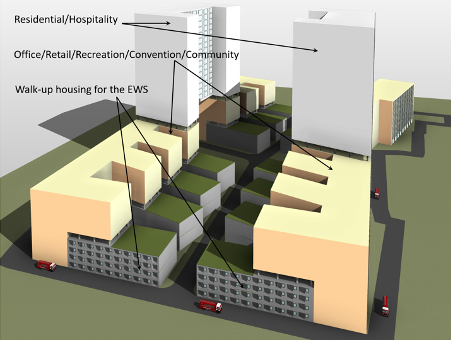In order to help combat adverse economic conditions prevailing at this time, accelerated implementation, completion and more importantly, successful occupancy by genuine beneficiary families in the Housing for all by 2022 mission is desirable.
With reference to the same, the following may be considered:
- Introducing mechanisms for ensuring accrual of benefits by genuine end-users, i.e. Indian citizens of EWS category including migrant workers and their families.
- Adding categories of housing and housing related provisions facilities which may be considered part of a wider definition of the ‘Housing for all by 2022’ programme
- Rentals with private houseowners
- Low-tariff hospitality models on Dharmshala or Sarai concept
- EWS employee housing as part of re-densified nodal urban projects such as DistrictCentres etc., aligned with TOD framework
- Innovative modular and/or transportable temporary housing for constructionworkers
- Long-stay rental accommodation
- EWS homes in greenfield developments
- Widening categories of private partners in PPP format capable of delivering options mentioned in (2) above, including but not limited to private house-owners, MSMEs, hospitality companies, management entities of nodal urban projects, employer corporations and industries, construction companies, private developers etc.
- Creating conditions conducive for rapid emergence of and delivery by ‘dispersed initiative’ in the form of financial and trade incentives packaged in sector-specific form
Generally, all categories may integrate built-in mechanisms that guard against pressures from land prices and speculation on the one hand, while maximizing initiative, involvement, and collaborative participation from all stakeholders on the other.
In order to illustrate potential in categories 2b and 2f above, two examples are presented.
The first example, for category 2b, is a you-tube video review of a Dharamshala in the Sadar Bazaar area of Delhi (link to video: https://youtu.be/5CE44FGlkWY). It presents key attributes that are culturally, climatically and economically appropriate for graduation to a contemporary Indian facility for short to medium duration stay across the country. Of specific interest is the fact that inner courtyards and the haveli pattern of planning are not only traditional to India but lend themselves very well to every category of hospitality. This is revealed clearly by Indian dharmsalas at one end of the scale, and by exclusive heritage hotels at the other.
The second example, for category 2f, is a planning study prepared as an alternative for a current EWS housing project in the PPP format, wherein twenty five sq. m. flats are organized on either side of a doubly-loaded corridor of approximately 1.5 metre width, in multi-storey buildings of sixteen floors high. Figure 1 below, from planning studies undertaken, shows a large mixed land-use integrated project for urban India that can deliver walk-up four storeyed apartments for EWS while allowing for TOD category mixed land-use and densities to be achieved.
Key attributes of walk-up apartments for the EWS category include:
- Consonance with planning model preferred by beneficiary families (sic: based on interaction with sample population through survey, meetings and a public presentation of concept)
- No requirement of lifts and elevators that would otherwise be necessary in high-rise development saving energy and both capital and maintenance expenses
- Relatively higher proximity to ground, allowing increased contact with outdoor and other resources by residing family members
- EWS part of development has lower technical complexity and therefore cost
